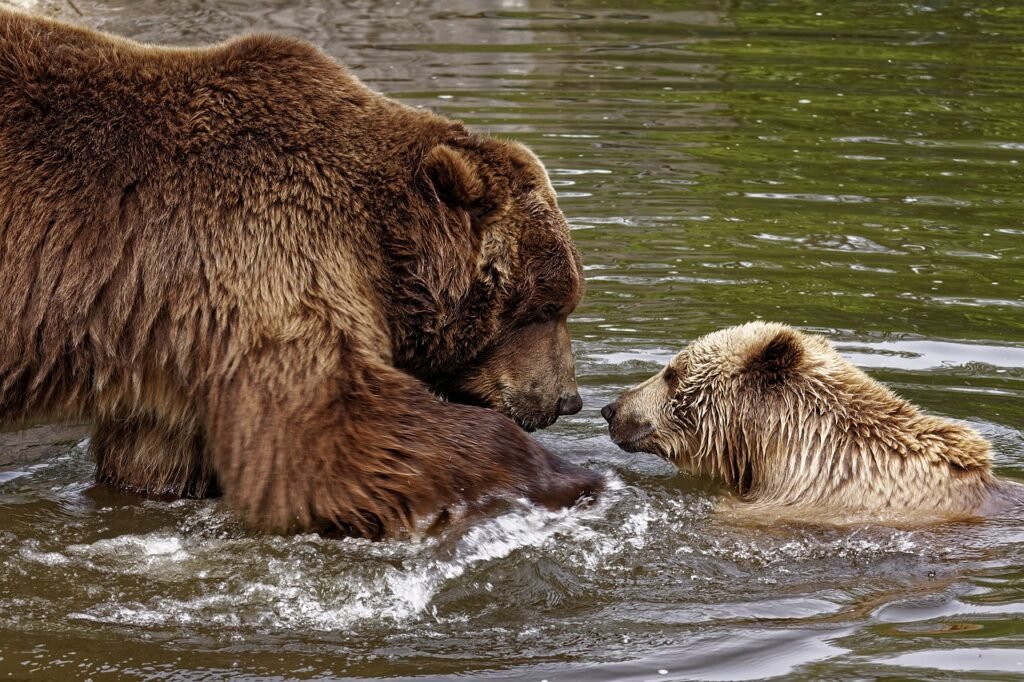Imagine you’re out on a beautiful hike, admiring the picturesque views and peacefulness of nature. Suddenly, you find yourself face-to-face with a wild animal. Panic sets in as you try to figure out the appropriate course of action. In this article, we will provide you with helpful tips and guidelines on what to do when you encounter wildlife while hill walking or rambling. Keep reading to ensure you’re prepared for any unexpected encounters on your outdoor adventures! Encountering wildlife while hill walking or rambling can be an exciting and memorable experience. However, it is important to remember that wildlife should be observed from a safe distance and with respect for their habitats. To ensure a positive encounter, there are some general guidelines to follow.
General Guidelines
When encountering wildlife, it’s crucial to stay calm and avoid sudden movements. Sudden movements can startle animals and potentially lead to aggressive behavior. Instead, try to move slowly and quietly, giving the wildlife space to continue with their natural activities.
Approaching wildlife should be avoided at all costs. Getting too close can disrupt their behavior and cause stress to the animals. It’s important to remember that wildlife is just that – wild. Giving them space not only protects their safety but also ensures your own.
Pets should be kept under control, either by leashing them or maintaining close supervision. Uncontrolled pets can disrupt wildlife and potentially even endanger them or themselves. It’s important to respect the natural environment and keep pets from chasing or harassing wildlife.
Observing wildlife from a distance is the best way to appreciate their beauty without interfering with their natural behavior. Use binoculars or telescopes to get a closer look and take photographs. Remember, capturing moments on camera is a great way to preserve memories while minimizing disturbance.
Encountering Large Mammals
Encountering large mammals, such as bears or moose, can be awe-inspiring but also potentially dangerous. To ensure a safe encounter, it’s important to follow some key guidelines.
Firstly, staying quiet and avoiding direct eye contact is crucial. These animals may perceive direct eye contact as a threat, so it’s best to avert your gaze and keep a calm demeanor. Additionally, speaking in a low and soothing tone can help maintain a non-threatening atmosphere.
If you find yourself too close to a large mammal, it’s important to back away slowly without turning your back or running. Sudden movements can trigger an instinctual chase response in some animals, so it’s important to move slowly and purposefully.
Making yourself appear bigger can also help deter potential aggression. You can achieve this by raising your arms or holding out any objects you may have, such as clothing or bags. In extreme cases where you have bear spray available, following the instructions on the canister can be an effective deterrent.

This image is property of pixabay.com.
Encountering Birds
Birdwatching can be a fascinating and enjoyable activity while hill walking or rambling. However, it’s essential to follow some guidelines to ensure the safety and well-being of the birds.
Avoid disturbing nests or young chicks. Nest disturbance can result in abandonment or harm to the birds. It’s important to respect their breeding grounds and observe from a safe distance. Binoculars can enable you to observe birds up close without causing any harm or distress.
Getting too close to birds can cause stress and may disrupt their natural behaviors. It’s crucial to maintain a respectful distance to allow them to feed, socialize, and rest without disturbance. By doing so, you can observe their natural behaviors and gain a deeper appreciation for these beautiful creatures.
Feeding birds may seem like a kind gesture, but it’s best to avoid doing so. Feeding can disrupt their natural foraging behaviors and may introduce dependency on human-provided food. Birds are best left to rely on their natural food sources to maintain a healthy diet.
Encountering Reptiles and Amphibians
When encountering reptiles and amphibians, such as snakes or frogs, it’s important to remember that they play an essential role in their ecosystems. To ensure a safe and respectful encounter, here are some guidelines to follow.
Provoke or handle reptiles and amphibians. These creatures are generally shy and prefer to be left alone. If you come across them, it’s best to observe from a safe distance and refrain from any actions that may cause stress or harm.
Step carefully and watch your footing when walking in areas known to have reptiles or amphibians. These animals may blend into their surroundings, making it easy to accidentally step on or disturb them. By being cautious and aware of your surroundings, you can minimize any potential harm to these fascinating creatures.
When hiking with children, it’s important to explain the principles of respecting wildlife and the importance of giving reptiles and amphibians space. Keep children close and discourage them from touching or attempting to catch these animals. Their safety and the well-being of the wildlife should always be the top priority.
Be cautious near water bodies, as reptiles and amphibians are often found in these habitats. When walking or rambling near ponds, lakes, or streams, maintain a reasonable distance and avoid actions that could disturb or startle these creatures.

This image is property of pixabay.com.
Encountering Insects and Arachnids
Insects and arachnids are an integral part of the natural world, but encounters with them can sometimes be uncomfortable or even dangerous. By following some guidelines, you can minimize the risks and enjoy your hill walking or rambling experience.
Wearing appropriate clothing is one of the best ways to protect yourself from insect bites and stings. Long-sleeved shirts, long pants, and closed-toe shoes can minimize exposed skin and reduce the risk of bites or stings.
Using insect repellent is another effective measure to keep insects at bay. Apply repellent that contains active ingredients like DEET or picaridin to exposed areas of skin. However, it’s important to follow the instructions on the repellent and avoid applying it on broken or irritated skin.
When encountering insects or arachnids, it’s crucial to avoid touching or swatting them. Swatting can sometimes provoke defensive behavior and increase the risk of bites or stings. Instead, calmly and slowly move away from them or wait for them to move away.
Ticks are a particular concern in some areas. These small arachnids can transmit diseases, so it’s important to be cautious and check for bites after being in tick-prone environments. Inspect your body, clothing, and gear for any ticks, and if found, carefully remove them using tweezers or a tick removal tool.
Encountering Marine Wildlife
Encountering marine wildlife, such as seals or dolphins, can be a rare and magical experience. It’s important to remember that marine animals should be observed from a distance to avoid causing stress or harm. Here are some guidelines to ensure a responsible encounter.
Approaching or disturbing marine wildlife should be avoided at all costs. Keep a safe distance to avoid interfering with their natural behaviors or hindering their movement. By doing so, you can observe these magnificent creatures in their natural habitat while minimizing any potential disturbance.
Just like with land animals, it’s important to resist the temptation to feed or touch marine wildlife. Feeding can disrupt their natural foraging patterns and may expose them to harmful substances. Touching wildlife can also cause stress or injury to both the animals and yourself.
Observing marine wildlife should be done with respect for their natural behavior. It’s crucial to be aware of any regulations or guidelines set by local authorities to ensure responsible interaction. Staying informed and educated about the creatures you encounter can enhance your experience while ensuring their well-being.

This image is property of pixabay.com.
Encountering Farm Animals
In rural areas, encounters with farm animals are common while hill walking or rambling. To ensure a safe and peaceful encounter, it’s important to follow these guidelines.
Respecting the landowner’s property and animals is essential. Remember that these animals belong to someone and may require specific care or handling. Trespassing or causing any distress to the animals is not only disrespectful but can also have legal consequences.
Avoid sudden movements or loud noises when approaching or passing farm animals. Animals may get startled by sudden noises or movements, which can lead to unpredictable behavior. By staying calm and quiet, you minimize the risk of causing any distress to the animals or endangering yourself.
Maintain a safe distance when encountering farm animals. It’s important to remember that these animals may not be accustomed to human interaction and may exhibit defensive or unpredictable behavior. By keeping a respectable distance, you can minimize any potential risks.
As tempting as it may be, it’s best to avoid feeding or touching farm animals. Their diet is carefully managed by their owners, and feeding them inappropriate food can lead to digestion problems or other health issues. Touching animals can also disrupt their natural behavior and may even cause injury to both parties.
Encountering Predatory Wildlife
Encountering predatory wildlife, such as wolves or cougars, can be intimidating, but it’s important to stay calm and act appropriately. Here are some guidelines to follow during such encounters.
First and foremost, staying calm and not showing fear is crucial when encountering predatory wildlife. Animals can sense fear and may view it as a sign of weakness or vulnerability. By maintaining a calm and confident demeanor, you can potentially prevent any escalation of the encounter.
Backing away slowly while facing the animal is the recommended course of action. Turning your back or running can trigger a predatory instinct and potentially lead to an chase. By facing the animal and slowly moving away, you communicate that you are not a threat and allow the animal to maintain its distance.
Understandably, it’s important to refrain from any actions that may provoke the animal. Avoid making sudden or threatening movements, and do not attempt to approach or touch the animal. By maintaining a respectful distance and behaving in a non-threatening manner, you can ensure a safe encounter for both yourself and the wildlife.
If you have any deterrents, such as noise-making devices or bear spray, it’s worth considering their use during a predatory wildlife encounter. These tools can serve as a last resort and potentially deter the animal from approaching further.
Encountering Snakes
Snakes are fascinating creatures that generally prefer to avoid human interaction. To ensure a safe encounter and minimize the risk of harm, it’s important to follow these guidelines.
Giving snakes space and not provoking them is crucial. These creatures rely on camouflage and stealth to stay hidden and avoid predators. If you come across a snake, it’s best to observe from a safe distance and allow it to continue on its way undisturbed.
Backing away slowly and keeping a safe distance is the best course of action when encountering a snake. Snakes are generally non-aggressive and prefer to retreat rather than confront humans. By giving them space and maintaining a respectful distance, you minimize the risk of accidental bites or harm to the snake.
Handling or attempting to catch snakes should be avoided unless you have proper training and knowledge. Snakes can become defensive and bite if they feel threatened or cornered. For your safety and the well-being of the snake, it’s best to leave snake handling to experts.
Snakes play an essential role in controlling rodent populations and maintaining ecological balance. Killing or harming snakes disrupts this delicate balance and can lead to negative environmental consequences. Instead, appreciate their beauty and importance from a safe distance.
Reporting Encounters
If you come across any wildlife encounters that raise concerns or pose a potential threat, it’s important to report them to local wildlife authorities. Reporting allows experts to assess the situation and take appropriate action to ensure the safety of both humans and wildlife. Here are some guidelines for reporting encounters:
Contact local wildlife authorities, such as a park ranger, conservation officer, or wildlife rescue organization. These experts are trained to handle wildlife encounters and can provide guidance or assistance as needed.
Provide as many details as possible about the encounter. This might include the specific location, the type of animal involved, and any aggressive behavior displayed. The more information you can provide, the better equipped the authorities will be to assess the situation and determine the appropriate course of action.
Follow any instructions given by the wildlife authorities. They may request additional information or ask you to take certain precautions in the future. It’s important to heed their advice and cooperate fully to ensure the safety of both yourself and the wildlife.
Reporting aggressive behavior is particularly important as it helps authorities monitor and manage potentially dangerous situations. If you witness any aggressive behavior from wildlife, such as charging, lunging, or growling, it should be reported promptly to the relevant authorities.
By following these guidelines and acting responsibly when encountering wildlife, you can enjoy a safe and enjoyable hill walking or rambling experience. Remember, observing wildlife from a distance and respecting their natural behavior is the best way to appreciate their beauty and ensure their well-being. With these tips in mind, get out there and explore the wonders of the natural world!
Hi there! I’m the Editor, experienced outdoor development specialist, mountaineer and the mind behind ‘Country Rambler.’ I’m thrilled to welcome you to our website, your go-to destination for all things hill walking and rambling. Whether you’re an experienced adventurer or just dipping your toes into the great outdoors, I’ve got you covered. From providing guidance on essential gear, like boots and jackets, to sharing trail tips that range from peaceful paths to challenging peaks, I’ve got everything you need to embark on your next adventure. Stay in the loop with our fresh news updates and trail information. So, lace up those boots and join me as we explore the breathtaking landscapes together. Happy wandering!


